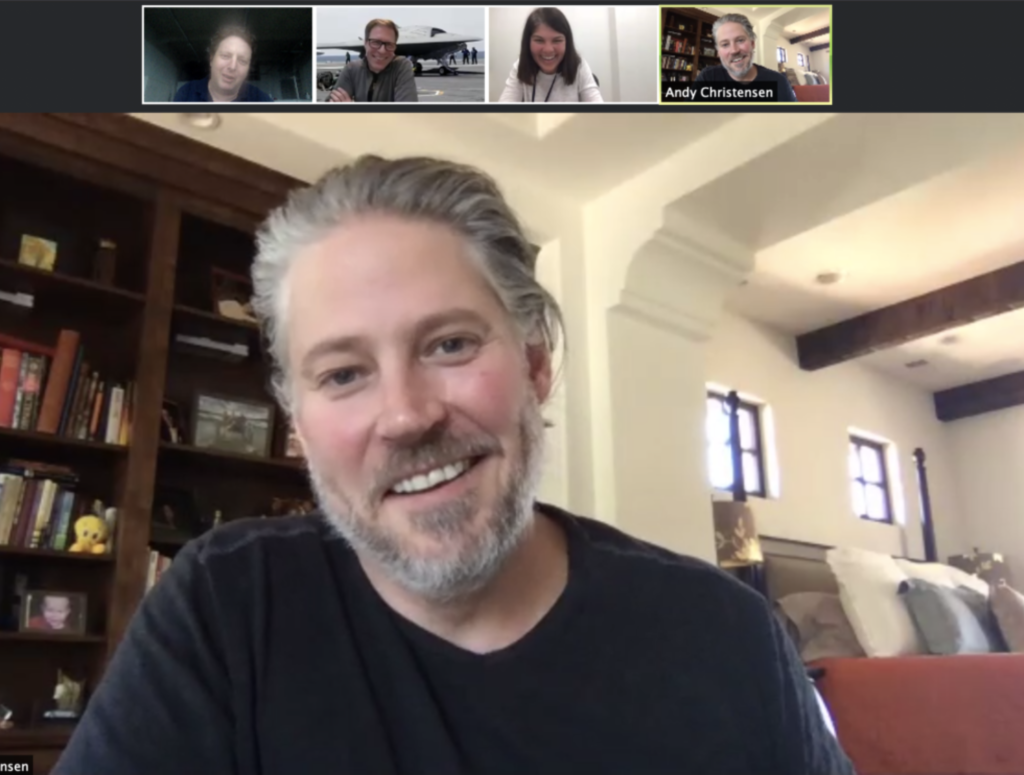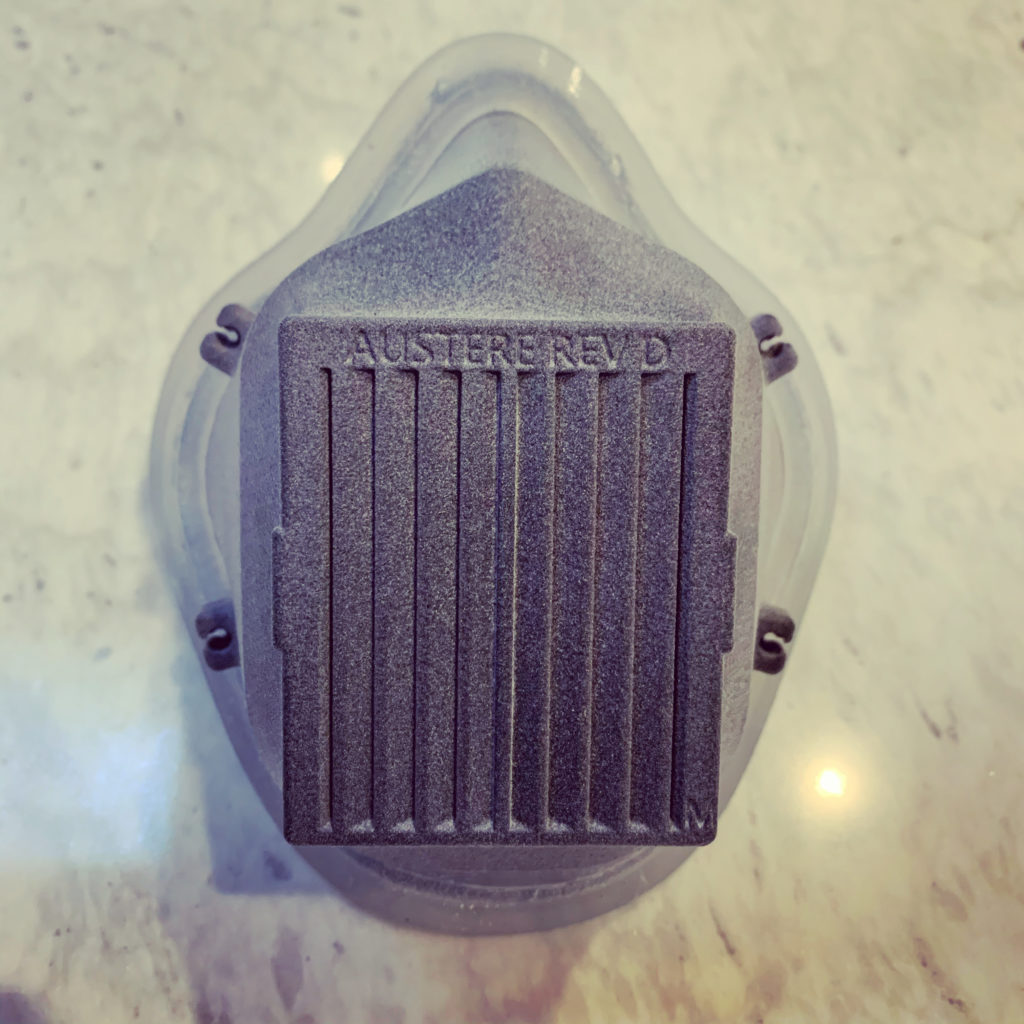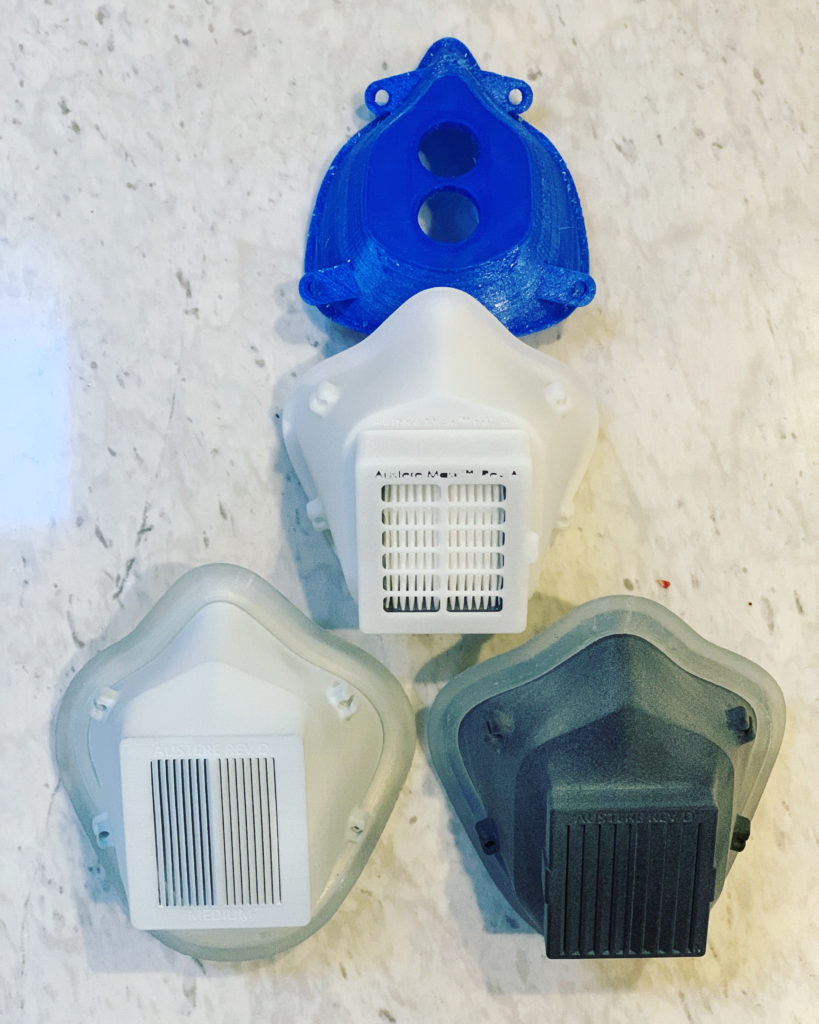COVID has spurned a lot of innovation in product design and development, especially in medical products. But, creating a respirator or ventilator is not quite the same as a Yoda head. A remarkable collaboration between the Barnes Group Advisors (TBGA) and the Veterans Administration (VA) is trying to make a new kind of respirator a reality through 3D printing. With the VA working with a very experienced set of 3D printing consultants on a difficult product, this has to be a thorough process.

Andy Christensen is the large Zoom view while we have me, John Barnes and Beth Ripley up top left to right.
I spoke with John Barnes, the head of the Barnes Group Advisors and one of the most knowledgeable people worldwide in 3D printing for manufacturing, especially in the field of aviation. After helping to introduce 3D printing to Lockheed, he’s now a university lecturer at Carnegie Mellon and RMIT Universities. Also present on our call was his colleague, Andy Christensen, who specializes in 3D-printed medical devices, is an Adjunct Professor of the University of Ottawa’s Radiology department and a board member of the Radiological Society of North America (RSNA) Special Interest Group on 3D Printing. The RSNA group is becoming very influential in the adoption of 3D printing in the medical field by consistently putting out useful information. Also hugely influential is Dr. Beth Ripley, the Director of the VHA 3D Printing Network at VA Health Care Systems and also a radiology professor. She’s in charge of the VA’s extensive evaluation and adoption of 3D printing and is now working tirelessly to get 3D-printed medical parts out the door to address the COVID crisis.
John feels that it is crucial to realize that “in medicine, we’re not just making shapes.” He says that “we want to invite creativity explosions” and “make hospitals and practitioners a greater part of designs” because we “have to understand how disease is treated.” But, “medicine is messy, human physiology is messy,” and we have to “make these products in a regulated and controlled environment.”
Andy concurs, “a medical device is different and however well-meaning, people need to make shapes but should make them with the rigors of a medical device.” He says that “it has to be meaningful and the focus has to be on quality. We should always add rigor to something that has no rigor.” Beth believes that even in “fear factor-driven times… collaborations such as the VA, NIH and FDA alliance… show that you can develop products that work.” “The need is real; it is not hype… we need to develop new products and prototype new products… we need to reimagine these devices as fast as possible.” She also believes that, whereas “3D printing gives you real agility in prototyping, often in the final part, manufacturing moves to other technologies.“

A revision of the Austere Mask, the RevD.
Through “partnering with TBGA… we’re back on the frontlines testing new devices..with the talents and talents drawn from both the VA and TBGA…we now have the bandwidth to do it.” She is encouraging but careful with regards to all of the 3- printed medical developments going on. She sees much more innovation emerge now, but most are derivations of the same few designs. She would like to see more design criteria drive adoption.
For the Austere mask project, the team wanted to create a “sterilizable and reusable mask that lasts for months.” Beth wanted to from “a new philosophy, iterate, test, and design a mask made for a totally disrupted supply chain.” After three weeks of iterations, the team is now field testing and trying to destroy the mask by “throwing them against the wall.” Being able to “incorporate feedback into the design, iterate rapidly and test…is a new way of working. Now we can do..human-centered design and..use the democratization of design to make the right products.”
The name Austere was not chosen at random. Austere is defined as something extremely simple without any ornament or excess. An Austere environment or austere military environment or austere medical environment is an area where soldiers, medics or medical personnel have limited tools and resources. There could be an ongoing threat or the city could be in rubble from an earthquake; there could be limited hospital staff or a limited amount of medicine. Power, communication, and, on the whole, resources are so limited as to necessitate operation wholly or in part outside of the standard way of doing things. I think this is an excellent name for a time when we’re finding that time, and the ability to have certain products available, is a considerable constraint that can directly affect our lives.

The evolution of Austere masks starting with FDM. It is exciting to see how the fit to the face was improved by a wider more flared mask.
Soon the team will iterate once more, freeze the geometry and finalize designs for injection molding. The Barnes team has learned a lot from the NFL Helmet Challenge, according to John. The Austere team, therefore, has spent a lot of time testing for different face types and scenarios. With the NFL Challenge, “we learned that the lineman is different than the receiver; their reason for getting concussed is different, so they need different helmets.” This is typically the type of thing that 3D printing is very good at. “One mask design may not be great for every face…we have thousands of different faces…and now can test new mask designs on many faces.” John and Andy also worry about both efficacy and single-use plastics. Andy Christensen says that “we’re running fast to respond to an emergent need. Now, you’re using one mask per week or per day. A [disposable mask] is a terrible solution..we’re talking about 1 million, a 100,000 and many more parts.” A more sustainable mask would be a boon indeed.
As for home printing, Andy believes that with the “FDA is relaxing guidelines for face shields because they’re perceived as such a low risk device…that now almost anyone can make.” He still urges people to “use [Good Manufacturing Practices (GMP)] and a medical device facility…even with the Emergency Use Authorization that only exists during a national emergency.”
Once we “move up the risk categories to respirators,” these measures should be much more stringent still. He feels that “there is a line where face shield frames, ear savers…give local people the opportunity to do something..to make a dent.” But even though “some are very professional,” he sees a need for “America Makes, the NIH or the FDA…to vet specific designs.” He sees these kinds of platforms as necessary to “connect to people who have need with industry.”
Beth concurs and thinks that mostly “3D printing is there for rapid prototyping” and while “desktop FDM is faster,” it is important to consider things such as “how do you do the [quality control] step?” She wants to find out how we can correctly label, trace, package, and spread parts. Things like “manufacturing instructions and technical data packages” are crucial. Progress is happening, and she specifically cites the “University of Washington that has really accessible instruction.” Beth wants more innovation and experimentation, but it “should not be a free for all.” In her tests of home 3D-printed medical parts, “the majority fail.”

Multiple revisions of the Austere masks. Note the differences in fasteners, vents, and lettering. The overall evolution of the shape and fit is also notable. Think also about how much easier to clean the MJF version is (bottom right) than the others.
Testing availability is currently lagging behind 3D-printed innovation in the medical space. Beth says that “a lot of people simply don’t have access to ASTM standards [compliant] testing and that they only do rudimentary testing.” Their teams also “put on their test respirators and run in the hall…and do improvised pressure drops,” but, happily, they do have access to testing partners. Most do not. The team works with Army research labs that can run the same kinds of tests that NIOSH does, a boon that lets them do exacting, subelement and filtration testing.
In terms of technologies, the team has found itself gravitating toward Multi Jet Fusion (MJF) and selective laser sintering (SLS) for masks. In Andy’s past, he was very stereolithography (SLA)-minded because he “used to be SLA all day every day…in long-term contact and long term-tissue contact applications from two hours to 30 days” and likes “SLA’s surface quality and transparency” in parts such as surgical models and guides. The team is also impressed with how SLA is being used at scale to make millions of nasal swabs. With SLS polyamide (Nylon), “you have a more robust, tough technology” that can be used “for example for things [that might be] in the mouth for 30 days..and other long-term contact.” He says that “if we’re looking at production quality…it mostly isn’t FDM at the moment.”
The team prototyped a lot using desktop machines and is now iterating with SLS and MJF. Two main prototypes were selected and tested extensively. Whereas initial versions will probably be made in SLS or MJF. After that step, they then wish to focus on tooling and design for manufacturing to get the mask injection molded. The team works in Solidworks and have semi-regular zoom calls to review and plan overall progress. They “know where they’re going” according to Beth, which helps keep communication to the necessary “focusing on design review, improvements and testing.”
Having said that, the team talks on Zoom every day to each other to keep up the momentum. A key question for her is “how can you scale across technologies…and make a new GMP-certified respirator?” How does one go from one prototype to a small series to then a safe and approved product? That is precisely the challenge that the team is working on now. Balancing innovation and cutting edge, new processes with safety and efficacy is very challenging. Famously on projects, you have: “good, fast, cheap—choose two” and, with 3D-printed medical devices, we see a similar balance of constraints emerging. However, in this case, the need and urgency are driving innovation from the unknown to the known and at a blistering pace. Perhaps the Austere mask will be a solution to unexpectedly austere times.
Subscribe to Our Email Newsletter
Stay up-to-date on all the latest news from the 3D printing industry and receive information and offers from third party vendors.
You May Also Like
3D Printing Unpeeled: New Arkema Material for HP, Saddle and Macro MEMS
A new Arkema material for MJF is said to reduce costs per part by up to 25% and have an 85% reusability ratio. HP 3D HR PA 12 S has been...
3D Printing News Briefs, January 20, 2024: FDM, LPBF, Underwater 3D Printer, Racing, & More
We’re starting off with a process certification in today’s 3D Printing News Briefs, and then moving on to research about solute trapping, laser powder bed fusion, and then moving on...
3D Printing Webinar and Event Roundup: December 3, 2023
We’ve got plenty of events and webinars coming up for you this week! Quickparts is having a Manufacturing Roadshow, America Makes is holding a Member Town Hall, Stratafest makes two...
Formnext 2023 Day Three: Slam Dunk
I’m high—high on trade show. I’ve met numerous new faces and reconnected with old friends, creating an absolutely wonderful atmosphere. The excitement is palpable over several emerging developments. The high...































